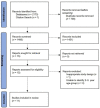Risk Factors for Overweight and Obesity within the Home Environment of Preschool Children in Sub-Saharan Africa: A Systematic Review
- PMID: 35565675
- PMCID: PMC9100775
- DOI: 10.3390/nu14091706
Risk Factors for Overweight and Obesity within the Home Environment of Preschool Children in Sub-Saharan Africa: A Systematic Review
Abstract
Sub-Saharan Africa (SSA) is experiencing an increasing prevalence of young children being overweight and obese. Many feeding and physical activity-related behaviours are established at home during preschool years, yet the precise factors that contribute to preschool overweight and obesity have not been fully elucidated. This review aims to identify factors in the home environment associated with overweight and or obesity in preschool children in SSA. Ovid MEDLINE, EMBASE, CINAHL, Scopus, Web of Science, Africa Journals Online (AJOL) and the African Index Medicus databases were systematically searched for qualitative and quantitative studies published between 2000 and 2021. Eleven studies (ten quantitative, one qualitative) met the inclusion criteria. Overall, the results highlight the paucity of studies exploring factors in the home environment associated with overweight and obesity in preschool children in Sub-Saharan Africa. The home food environment and maternal BMI appear to be important factors associated with overweight and obesity in preschool children; however, the information for all other factors explored remains unclear due to the lack of evidence. For successful obesity prevention and treatment interventions to be developed, more research in this area is required to understand how different aspects of the home environment contribute to overweight and obesity in preschool Sub-Saharan African children.
Keywords: Sub-Saharan Africa; home environment; obesity; overweight; preschool.
Conflict of interest statement
The authors declare no conflict of interest.
Figures
Similar articles
-
Evidence of an overweight/obesity transition among school-aged children and youth in Sub-Saharan Africa: a systematic review.PLoS One. 2014 Mar 27;9(3):e92846. doi: 10.1371/journal.pone.0092846. eCollection 2014. PLoS One. 2014. PMID: 24676350 Free PMC article.
-
Malnutrition among lactating women in sub-Saharan Africa: an analytic review of spatial distribution, burden and determinants.Front Public Health. 2025 Jun 3;13:1564581. doi: 10.3389/fpubh.2025.1564581. eCollection 2025. Front Public Health. 2025. PMID: 40529712 Free PMC article. Review.
-
Metformin for women who are overweight or obese during pregnancy for improving maternal and infant outcomes.Cochrane Database Syst Rev. 2018 Jul 24;7(7):CD010564. doi: 10.1002/14651858.CD010564.pub2. Cochrane Database Syst Rev. 2018. PMID: 30039871 Free PMC article.
-
Socio-economic status and overweight or obesity among school-age children in sub-Saharan Africa - a systematic review.Clin Obes. 2016 Feb;6(1):19-32. doi: 10.1111/cob.12130. Clin Obes. 2016. PMID: 26781602
-
Understanding Mental Health in the Context of Adolescent Pregnancy and HIV in Sub-Saharan Africa: A Systematic Review Identifying a Critical Evidence Gap.AIDS Behav. 2021 Jul;25(7):2094-2107. doi: 10.1007/s10461-020-03138-z. Epub 2021 Jan 15. AIDS Behav. 2021. PMID: 33452658 Free PMC article.
Cited by
-
Comprehensive systematic review and meta-analysis of risk factors for childhood obesity in China and future intervention strategies.Lancet Reg Health West Pac. 2025 Apr 23;58:101553. doi: 10.1016/j.lanwpc.2025.101553. eCollection 2025 May. Lancet Reg Health West Pac. 2025. PMID: 40336578 Free PMC article.
-
Helicobacter pylori infection and gastric microbiota: Insights into gastric and duodenal ulcer development.World J Gastroenterol. 2025 Feb 21;31(7):100044. doi: 10.3748/wjg.v31.i7.100044. World J Gastroenterol. 2025. PMID: 39991687 Free PMC article.
-
Socio-economic, demographic, and contextual predictors of malnutrition among children aged 6-59 months in Nigeria.BMC Nutr. 2024 Jan 2;10(1):1. doi: 10.1186/s40795-023-00813-x. BMC Nutr. 2024. PMID: 38167375 Free PMC article.
-
Comorbidities of childhood obesity at a tertiary hospital in Kwazulu-Natal, South Africa.Obes Pillars. 2025 May 24;15:100182. doi: 10.1016/j.obpill.2025.100182. eCollection 2025 Sep. Obes Pillars. 2025. PMID: 40525087 Free PMC article.
-
Link between childhood obesity and gut microbiota.World J Gastroenterol. 2024 Aug 14;30(30):3560-3563. doi: 10.3748/wjg.v30.i30.3560. World J Gastroenterol. 2024. PMID: 39193569 Free PMC article.
References
-
- World Health Organisation Obesity and Overweight. [(accessed on 16 March 2022)]. Available online: https://www.who.int/news-room/fact-sheets/detail/obesity-and-overweight.
Publication types
MeSH terms
LinkOut - more resources
Full Text Sources
Research Materials
Miscellaneous



